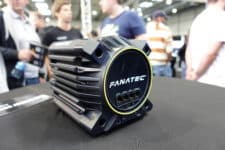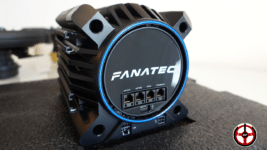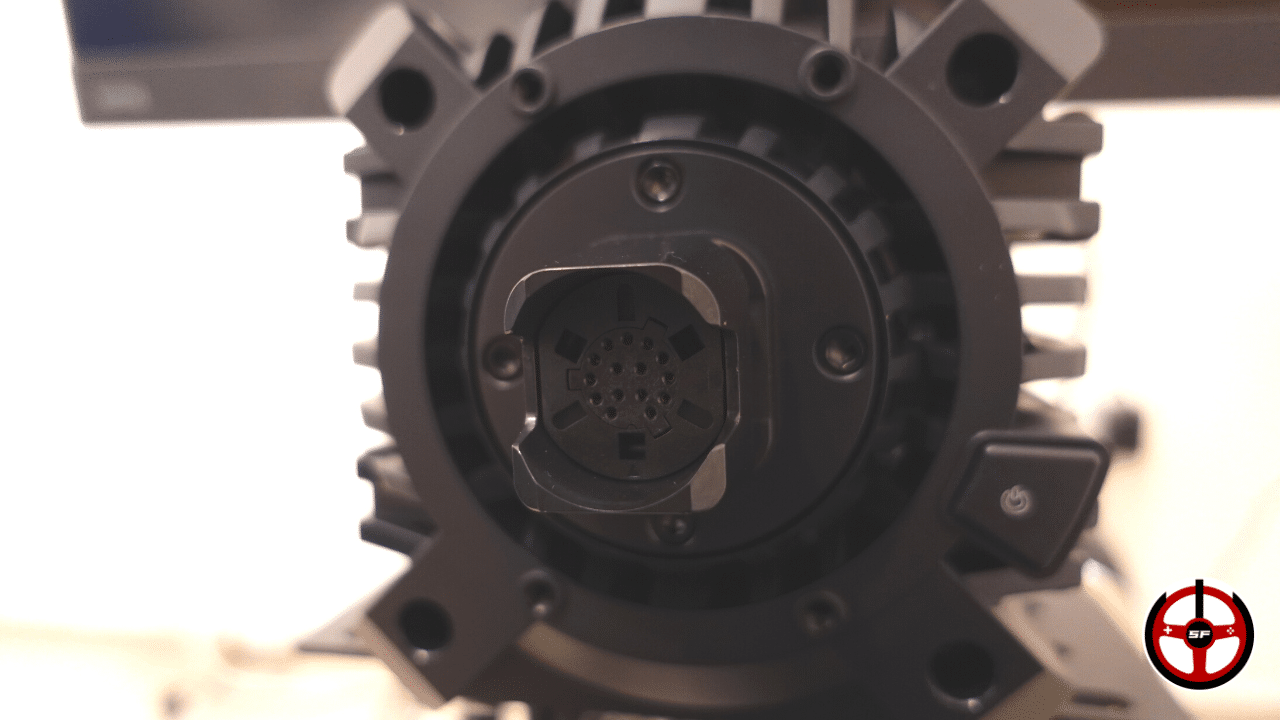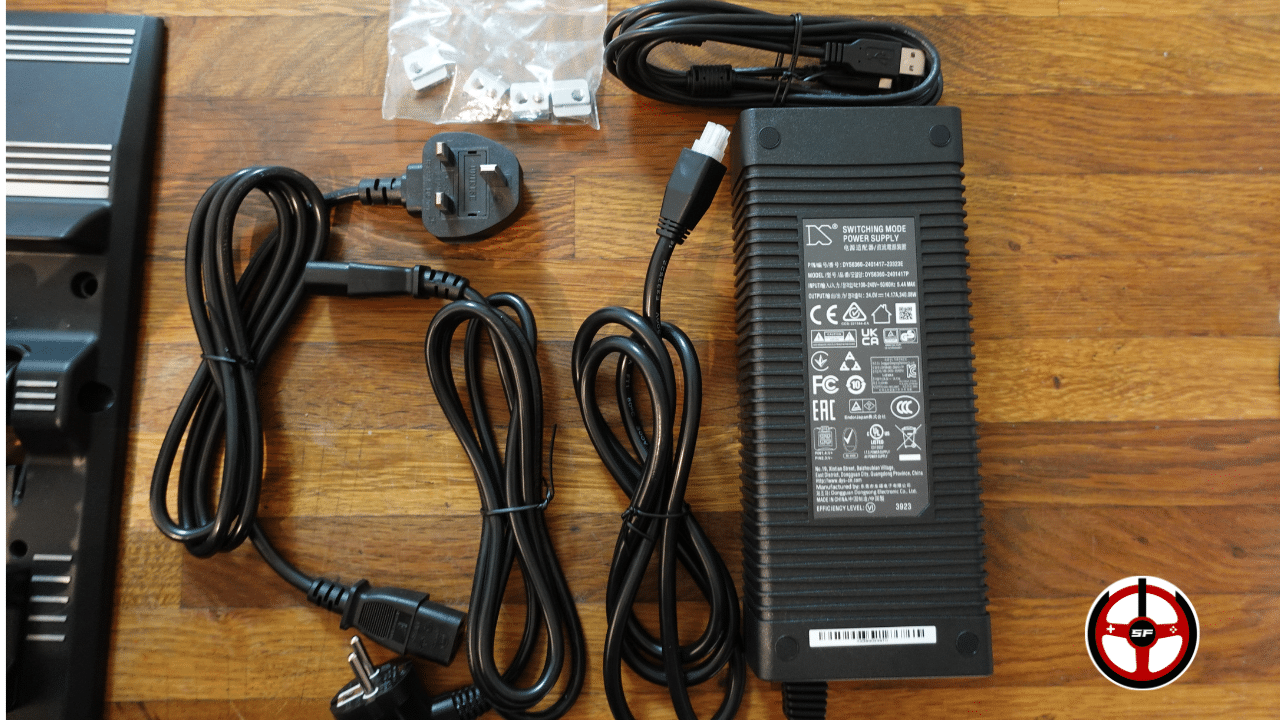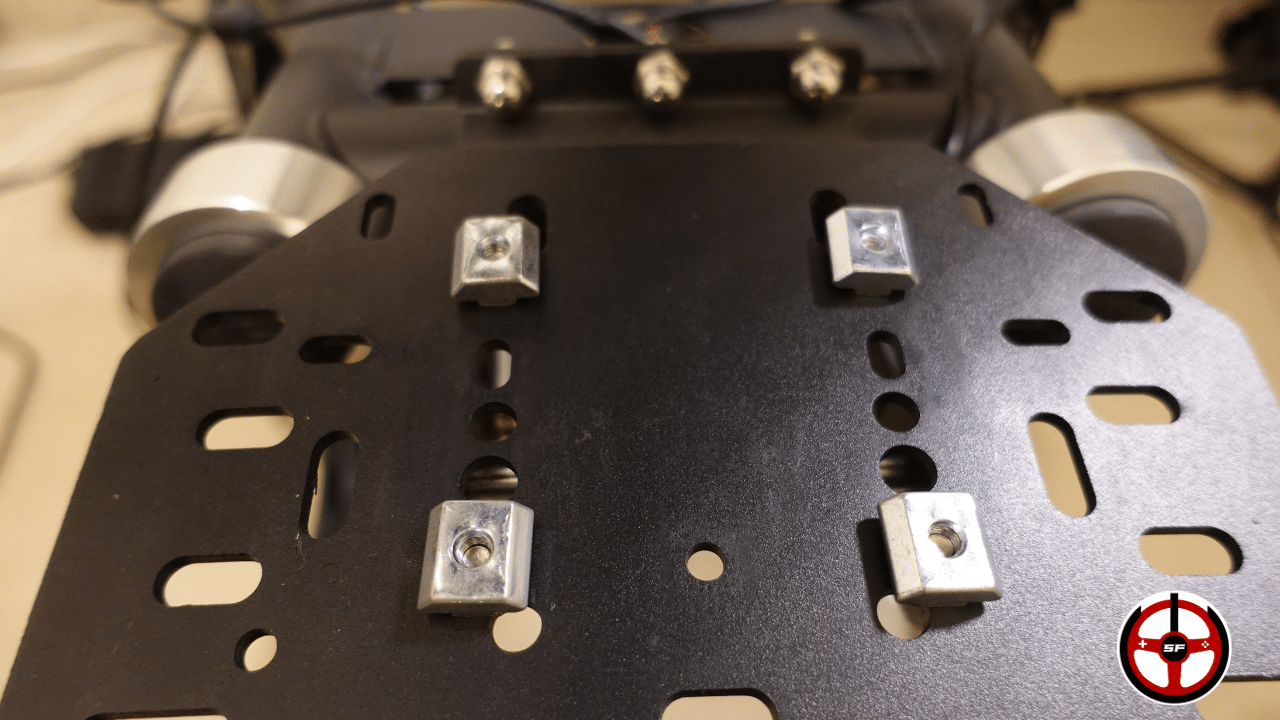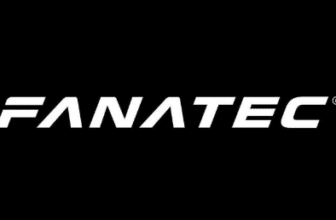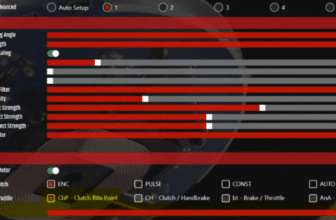
The Fanatec CS DD marks the German brand’s comeback in the mid-range Direct Drive sim racing battle. Hordes of gamers have been waiting impatiently for the new model to arrive, even if it meant switching to the competition. But rather than simply releasing a new base, Fanatec has chosen to offer a brand new force feedback protocol, FullForce. And from what the company’s CEO, Thomas Jackermeier, tells us, it’s got a lot going for it. Let’s check it out together in this eagerly awaited test of the new Fanatec ClubSport base!
Further tests are planned.
Fanatec CS DD in brief
Fanatec CS DD en bref
What does the Fanatec CS DD base mean technically?
| Compatibility | PC, X Box (if used with an X Box-compatible steering wheel) |
| Dimensions Weight | Length 20.2cm and 24.5cm incl. QR, width 15cm, height 15.6cm 10 Kg |
| Motor | Direct Drive – Brushless Servo Motor Fanatec |
| Torque | Peak: Not communicated Constant: 12Nm Slew Rate : Not communicated |
| Encoder | Not communicated |
| Turning range | 90° to 2520° Adjustable via software |
| Connections | 1 USB-C output to PC 1 340W power supply 1 CAN connection 1 Pedalboard connection 2 Shifter connections 1 Handbrake connection |
| Wheel mounting | Quick Release Fanatec QR2 |
Design and ergonomics
When unboxing, we are happy to see that the design and quality of finish have been improved. In any case compared to the CSL DD. The lines of the aluminum case remain quite raw because it is designed to keep the engine as cold as possible. But the plastic front and back have been well worked and fitted.
In the box:
– Fanatec CS DD wheelbase
– 340W power supply and 2 sockets for different geographical areas
– 1 USB / USB-C cable of 2.90m
– 4 T-nuts
– Quick start instructions
At the rear, you’ll find 4 sockets for connecting your Fanatec ecosystem directly to the base. Pedals, handbrake, shifter 1 (H or sequential) and shifter 2 (sequential only). Just below, you’ll find theUSB-C port for connecting the base to your PC or console. At the very bottom is a CAN socket that will be useful for future products (that we’ve been waiting for since 2021!). And finally, the power socket for connecting your 340W power supply unit.
On the front, we discover the pre-installed QR2. The power button, which will be used to switch the base unit on and off, as well as to change its mode (PC, Console, CSW 2.5 compatible). Ah yes… Did you notice? Above and below the Quick Release, there are 4 screw holes spaced 6cm apart on the width and 10cm apart on the height. These are used to install the Clubsport fixed vane module.
An in-house Fanatec motor
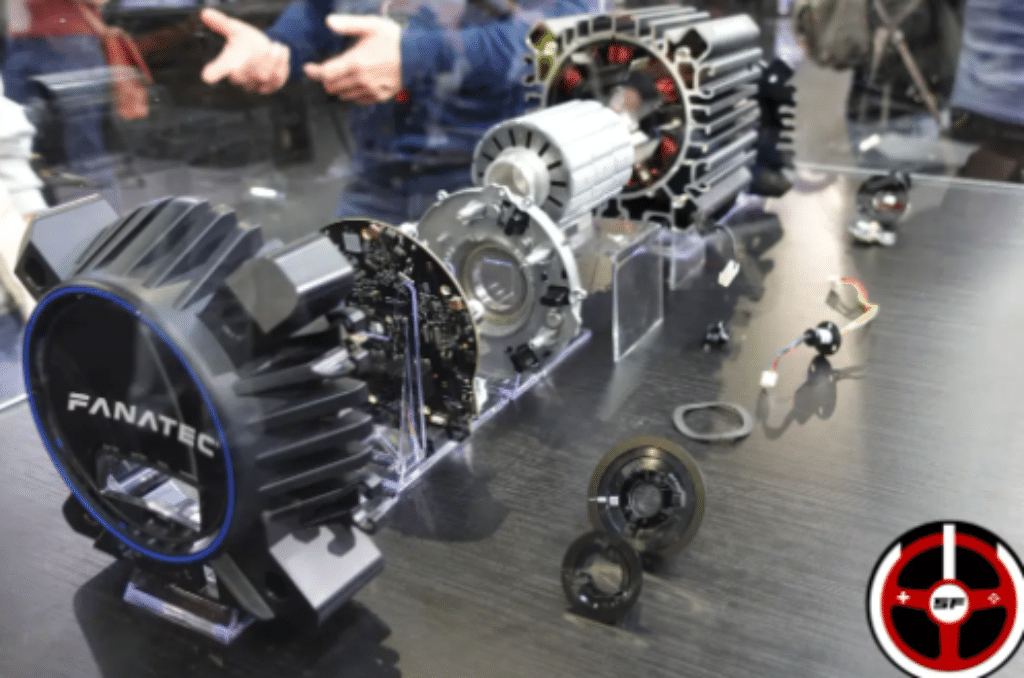
Now that we’ve had a good look around, let’s find out what’s inside. The motor is a Brushless Servo Motor. Developed in-house, it’s capable of delivering 12Nm of constant torque.
Unlike peak torque, which can only be delivered for a very short time, constant torque is the force that will be delivered even in long curves.
This puts it head and shoulders above the Moza R12, Simagic Alpha Mini and Asetek La Prima in this respect. Of course, torque isn’t everything. It’s also imperative to take into account the base’s reactivity (expressed in Nm/ms) and the encoder used. Unfortunately, Fanatec has declined to comment on these two points. So we’ll have to make up our own minds on these two aspects.
I’m not forgetting, of course, the software side! This is what will be used to translate the information sent by the game into movement details felt in our hands. But we’ll have to wait and see on that front too, as the FullForce protocol is not yet supported by games.
To discover: Thomas Jackermeier talks about the new ClubSport bases
One might be tempted to believe that a simple change in power supply would make it possible to push the torque of the CS DD to a constant 15Nm like its big brother the CS DD . I’ll stop you right away, no, it’s not possible and nothing has been planned in this direction by Fanatec.
Installing the Fanatec ClubSport DD base on the chassis
Reader, I’d like to warn you. Don’t put it on just any chassis. First of all, its engines are heavy. But above all, it is capable of developing forces that could prove dangerous if you install it on an unsuitable chassis or table. Choose a rigid chassis, unless you’re willing to sacrifice power by lowering the strength of the base, of course..
Got somewhere to put it? Great! Now let’s look at the options available. The first is to use the 3 rails under the base with the 4 T-nuts supplied in the box. However, the 4 M6 screws required for installation are not supplied. You’ll have to find them elsewhere (personally, I used 15mm M6). Feel free to have a look in your toolbox, as this is a fairly common size.
It’s worth noting that the base is a little high and that between the top of the steering shaft and the top of the base, there’s a thickness of 6cm. This is something to bear in mind if you want to get your screen as close to the steering shaft as possible. Once your steering wheel is in place, the thickness of the QR2 will further restrict this space.
If you don’t want to use the rails under the base, here are the other installation options:
- Metal table clamp with tilt adjustment (optional at 99.95€)
- Side mounting via the two rails on either side of the Fanatec CS DD.
Settings via Fanalab
Once the base is plugged in, all that’s left to do is switch it on and make a few simple adjustments. We’ll start by checking the centering of the flywheel, then for the more adventurous, we’ll tackle the force feedback. We’ve already spoken at length about the settings for Fanatec bases in our Fanalab tutorial. I’ve put the link just below. All the information remains the same, apart from the appearance of the “FullForce” setting. But as I said earlier, it’s not yet active in game.
See : Fanalab force feedback settings tutorial
The QR2 from Fanatec
After years of waiting, the new Quick Release 2 (QR2) steering wheel attachment system is finally available. This model, inspired by the Krontec models found on genuine GT3s, is both more practical than the old QR1… But it should also have a longer lifespan, and avoid the problems of bent connection pins found on older models.
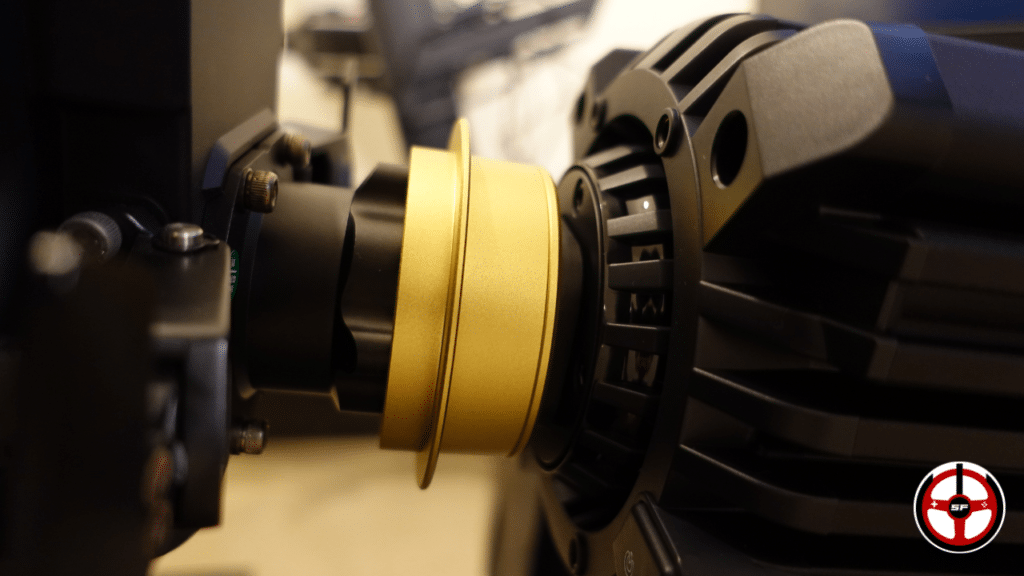
The QR2 connects the steering shaft to the steering wheel.
It can be fitted with one hand. Once engaged, it holds the steering wheel perfectly in place, without the slightest flex in the attachment. I did, however, observe some flex in my Fanatec CSL BMW steering wheel, but that’s another subject.
To remove it, pull the ring towards the steering wheel and the whole thing will be in your hands. Simple, effective and validated by real-life motor racing. I can’t think of anything I’d like to find fault with.
Comfort and sensations: a roller-coaster ride
Well, here goes my test routine again! I start off with the “factory” settings, to get a feel for the brand’s “out-of-the-box” intentions. Lots of damper, a little friction… Are we trying to camouflage cogging?
As a reminder, cogging is a slightly notched effect when the steering wheel is turned and the steering shaft moves from one magnet to another. You can feel it on all ServoMotor Brushless bases, with a few very rare exceptions. But filters can be used to limit this feeling, or even eliminate it altogether. BUT, to remove cogging, you need to add a damper effect and friction. Two effects that will eat into the fine details of the force feedback and limit reactivity somewhat.
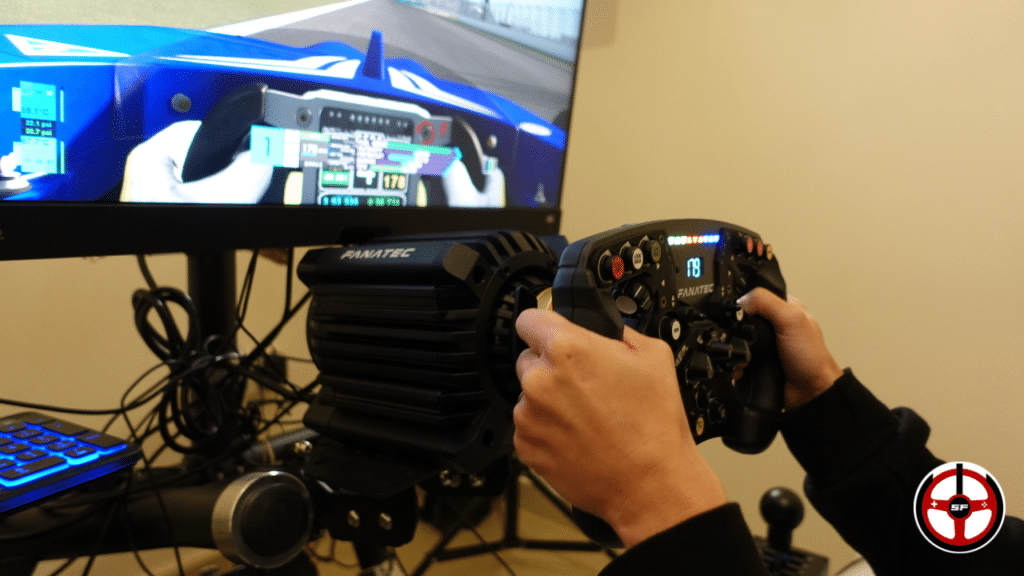
So I go back into Fanalab and remove all the effects. Unsurprisingly, cogging appears. Don’t panic, it’s perfectly normal on this type of motor. You’ll just have to find the right balance with the Damper and Friction effects to avoid feeling it, while retaining maximum force feedback detail.

After that, I continued my testing on different simulators and vehicle categories. And I must admit I was pleasantly surprised by the responsiveness of the base! Fanatec has handled this point really well, and the base seems to me as responsive as an Asetek La Prima, which is a compliment!
In terms of detail, it holds up well, but the mandatory damper to erase cogging really hampers its ability to surprise. Nevertheless, I think that with FullForce, it will be able to deliver a nice level of fine detail. But that remains speculative.
FullForce on hold
Yes, at the moment, no game supports FullForce! The first on the list will be iRacing. It’s a safe bet that Assetto Corsa Competizione will also feature it. And probably Gran Turismo 7, since Polyphony Digital is a partner of the brand. But as for the rest, it’s still a big mystery! And I have to admit that I’m really waiting for Fanatec on the FullForce.
Clipping with this base?
As a reminder, clipping is when your base’s force feedback becomes saturated and is no longer capable of transmitting details but only brute force. On low-power rig, this is a recurring problem, easily observed in long, fast corners, such as on an oval in Indycar racing.
Under normal racing conditions, pushing the base to 100% and the force to 75-80%, everything runs smoothly. But you know me, I don’t like half measures. I was still able to trigger clipping on Oval in Indycar, after 85% of play force. But the question to ask is “who’s going to race on an oval with the FFB at full power for 20-30-100 laps? The answer: me, of course, to see if we can get the base warmed up!
Warming up the base: a pleasant surprise!
In the interview we did at ADAC Simexpo, Thomas Jackermeier told us that their base had an unstoppable heat management system. And you know what I like to do when someone tells me something is unstoppable? Do everything in my power to put the machine to shame! So, as usual, I set off for 2 hours on an Indycar oval with the FFB base and game on full blast to see if I could get the machine to overheat.
And I came back with my tail between my legs! To the touch, I couldn’t feel any difference in temperature on the top or sides of the base. When in doubt, I removed the base from the chassis to find that the underside was only slightly warmer. So my one-sided muscle-building session was in vain!
Who would I recommend the Direct Drive Fanatec CS DD to?
At the moment, it’s hard to say whether we’d recommend it or not! In fact, as long as the FullForce system can’t be used in game, it’s out of the question. For the time being, yes, as it stands, it’s a good mid-range Direct Drive base. But it’s more expensive than some models with smoother motors. It’s really the FullForce that will make the difference, and allow me to give you a definitive opinion on the Fanatec Clubsport DD.
A slap in the face for the price, and a first review of the Fanatec CS DD
Fanatec did make one mistake. Thomas Jackermeier told me that the base model would cost €699.95. It’s possible that the price was intended as a special pre-order rate, but it wasn’t clearly announced. And then, a few weeks later, it unexpectedly went up to 799.95€. And €100 more means a different competitive environment!
But let’s not forget that the big asset of this base is the FullForce system. A system still inaccessible to gamers! So, will this new backlash be able to tip the balance definitively in Fanatec’s favor? I can’t predict. But it’s certain that expectations have gone from “great” to “dangerously critical”. The Germans will have to prove to us that FullForce will soon be available, and not just on iRacing!

